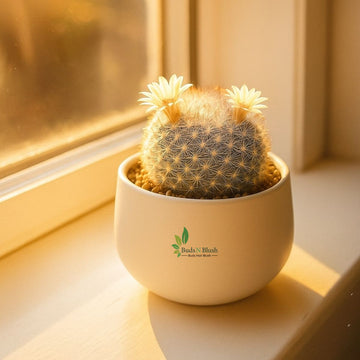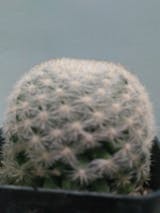✅ Mammillaria Candida – The Snow-White Crown of Desert Beauty
The Mammillaria candida, often celebrated as the Snowball Cactus, originates from the arid landscapes of northeastern Mexico. Its natural habitat is marked by intense sunlight, low humidity, rocky soils, and minimal rainfall. Thriving under extreme desert conditions, this cactus has adapted to store water within its plump spherical stems and shield itself with dense, white spines that glisten like fresh snow under the sun. Its native climate is hot during the day, cooler at night, and extremely well-drained—conditions that define its hardiness and enduring charm.
✅ Origin and Natural Habitat
-
Native to northeastern Mexico’s rocky, sun-drenched deserts.
-
Grows in well-drained, mineral-rich soils with minimal rainfall.
-
Adapts to high day temperatures and cool nights.
-
Dense white spines act as natural sun protection and water retention aid.
✅ Perfect Placement for a Stunning Home Aesthetic
-
Best positioned on south- or west-facing sunny windowsills.
-
Complements minimalist, rustic, or modern interiors beautifully.
-
Works as a striking stand-alone display or in succulent clusters.
-
Enhances home aesthetics when placed on white or natural wooden surfaces.
-
Perfect for open bookshelves, coffee tables, bedside tables, or office desks for an instant style boost.
-
Looks elegant in glass terrariums or ceramic pots on kitchen counters or console tables.
✅ Care Guide – From Nurturing to Blooming
-
Requires 4–6 hours of bright, direct sunlight daily.
-
Use cactus-specific, fast-draining soil with added perlite or coarse sand.
-
Water using the “soak and dry” method, ensuring soil dries completely before rewatering.
-
Fertilize monthly in spring and summer with a low-nitrogen, high-potassium formula (such as NPK 5-10-10 or 10-15-10) to encourage blooming and strong root health.
-
Alternatively, organic options like well-composted cow manure or liquid seaweed extract can be used in moderation.
-
Avoid high-nitrogen fertilizers, as they promote excessive soft growth that can harm the cactus.
-
Minimal pruning; remove only damaged or dried-out offsets to maintain symmetry.
-
To encourage its charming pink-to-purple blooms, provide a winter dormancy period at 10–15°C with reduced watering.
✅ Benefits of Growing Mammillaria Candida
-
Low-maintenance, long-living ornamental plant.
-
Purifies indoor air and uplifts mood.
-
Ideal for small spaces due to compact size.
-
Seasonal blooms add vibrant color to interiors.
-
Symbolizes endurance and elegance—perfect as a meaningful gift.
✅ Common Problems and How to Avoid Them
-
Overwatering is the most common cause of root rot—avoid waterlogged soil.
-
Insufficient light leads to elongated, misshapen growth (etiolation).
-
Occasional pests like mealybugs or spider mites—remove with soft brush or treat naturally.
-
Correct light, soil, and watering prevent nearly all issues.










